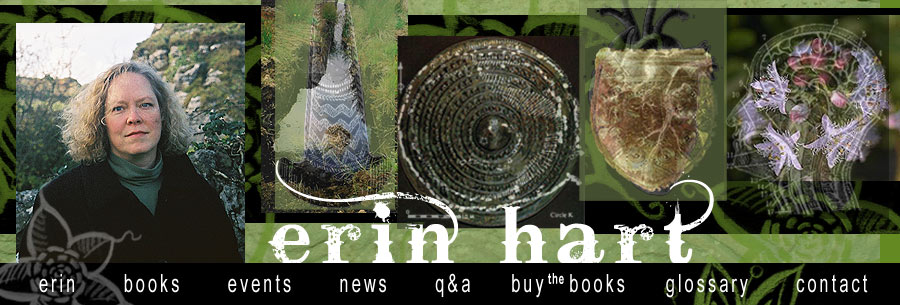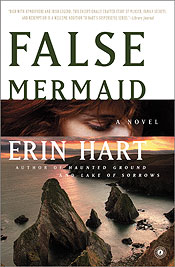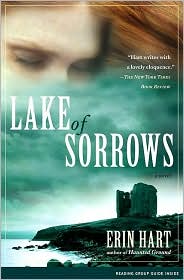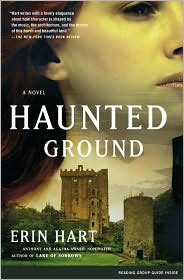Just finished the book club discussion questions for FALSE MERMAID. These will appear in the trade paperback edition coming out in March 2011. Let me know if you have other ideas or suggestions for discussion!
1. False Mermaid opens with a newspaper article about the disappearance of a young Irish woman believed in some quarters to have been a selkie (a seal temporarily transformed into a human). What ideas and images did this newspaper article bring to mind? How did the piece set up or color your impressions about how the novel would take shape?
2. What parallels do you see between the murder of Nora’s sister in Saint Paul, and the hundred-year-old disappearance of Mary Heaney, the young Donegal woman who was rumored to be a selkie? How relevant is the selkie story to the tale of Mary Heaney, or to Tríona Hallet’s death?
3. In the selkie myths from Ireland and Scotland, a fisherman captures the selkie by stealing her sealskin, which gives him power over her. Nora believes that her brother-in-law Peter Hallet had some sort of power over her sister Tríona. Did Peter Hallett actually wield such power over his wife, and what is the metaphorical ‘sealskin’ he has stolen from her?
4. Nora remembers what Tríona said, that Peter’s behavior seemed harmless at first, but that she ‘let things go too far.’ What do you think Tríona meant by this? Do you think it’s possible that she still loved her husband?
5. What are some of the qualities we associate with mermaids and selkies? They’ve been portrayed in art and literature as wild, primitive, irresistible, sometimes dangerous or wicked. They live in the sea—an unfathomable, mysterious world that’s inaccessible to humans. Some people say that on a psychological level, the mermaid/selkie’s dual nature—part human, part animal—represents men’s irrational fear of female sexuality. What do you think?
6. Why do you think that so many people—and so many women, in particular—identify with the plight of the selkie, the mermaid, the fairy-bride? What sorts of impossible choices are ordinary human beings faced with every day—choices perhaps given symbolic flesh by the selkie’s dilemma?
7. Division is one of the major themes in False Mermaid. The novel itself can be seen as divided, on the one hand functioning as a detective story, complete with forensic evidence and clues, and on the other hand exploring the mysterious underworld of the subconscious. Many characters in this novel are also divided, either figuratively or quite literally; what sorts of references to divided creatures did you perceive as you read the story?
8. Shape-shifting and transformation are among the major themes in False Mermaid. Several characters are shown changing shape, wearing disguises, or assuming a different identity. Can you think of several instances where this sort of change is depicted or suggested?
9. Ireland has long been a place where belief in the otherworld remains strong. But doesn’t the American portion of False Mermaid also contain other-worldly elements? Which characters, scenes, or images in the Saint Paul-based chapters help to underscore the novel’s other-wordly atmosphere?
10. There are numerous fairy-tale elements in False Mermaid: the unsettling danger that lurks in the woods at Hidden Falls, the crone on the park bench who tells Nora where to find Harry Shaughnessy, the one-eyed seal that appears in Seattle and later in Ireland, and perhaps most especially the notion of a seal shedding its skin and transforming into a human. How do these fairy-story elements and characters get under the surface of human emotions, and in what ways do you think they connect with our subconscious?
11. A woman leaving her husband, even an abusive one, was so unusual in the past that legends like that of the selkie may have been made up to explain it. What other bits of lore and legend could be interpreted in similar ways?
12. Tales of fairy abduction, fairy brides, selkies, and changelings often refer to the person in question being out of sorts, not herself—as in the lyrics of the mermaid song: ‘It seems you’ve faded away and abandoned the love of life.’ People who had lost the love of life were supposedly more susceptible to being taken away or transformed by other-wordly powers. Do you think stories of shape-shifting, abduction, or “spirit sickness” might have been a way to explain things like mental illness or depression in an age before these subjects were as broadly understood as they are now?
13. Each section of False Mermaid begins with a quotation from a Victorian folklorist or naturalist. What did you learn about the prevailing Victorian attitudes toward the subjects these men were writing about—the relationships between humans and animals, between civilized societies and so-called ‘primitive cultures’ (which included most of Irish rural culture at the time), and unsettling, ancient notions of female emancipation represented by the selkie stories?
14. Both Nora Gavin and her sister fear that they’ve lost the ability to distinguish truth from falsehood. Think about the different meanings of the words ‘true’ and ‘false.’ In folk songs, people are sometimes described as ‘true’ or ‘false’ lovers. How do these different meanings come into play in False Mermaid?
15. The title False Mermaid is an obvious reference to the botanical clue that eventually solves Tríona’s murder, but are there other references to a ‘false mermaid’ in the story? Did this story make you examine your own ideas and perceptions about gender roles and sexuality?
16. What sorts of experiences and connections do Elizabeth, Tríona, and Nora have with seals in this novel? If the one-eyed seal is a symbol, who or what do you think it represents? Doesn’t Cormac also discover something about his own previously unknown connections with seals and selkies?
17. Nora Gavin, in observing Elizabeth’s first meeting with Garrett Devaney’s daughter Róisín, thinks about the way children use ‘animal ways of knowing.’ Cormac and Devaney both seem to believe that children perceive much more than adults realize. How important is the element of nonverbal communication in this story? Do you remember any scenes where a person’s behavior is at odds with the words that character speaks?
18. Music plays a strong role in False Mermaid; it’s one of Nora’s strongest connections to her sister. Cormac also discovers that his father played traditional music at one time, something he didn’t realize that they had in common. How is music part of the thread of nonverbal communication that winds throughout this story?
19. Water is another important element in False Mermaid. The Atlantic and the Mississippi River are central to each setting. Why do you think water is such a powerful force in the human imagination?
20. The novel ends with Elizabeth unable to believe her father culpable in her mother’s terrible murder—how realistic do you think this choice was? Why do you think the author chose to leave Elizabeth Hallett’s feelings for her father unresolved?
21. Which were the most memorable scenes in False Mermaid? What ideas or images stayed in your mind after reading the book, and what were the most interesting bits of insight or information you gained?
22. How does Erin Hart’s work fit into the tradition of mystery/crime writing? Are there any authors—past or present—that you would consider similar in style or tone?
Many to Wendy Webb, Marlyn Beebe, Marlys Johnson, and Linda White for their excellent ideas and suggestions. Go raibh mile maith agaibh!













